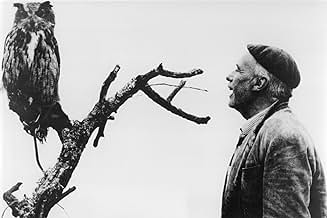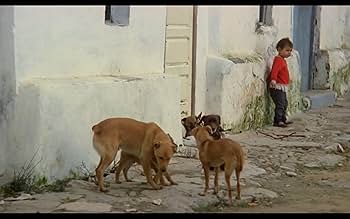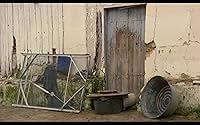IMDb रेटिंग
8.1/10
5.1 हज़ार
आपकी रेटिंग
अपनी भाषा में प्लॉट जोड़ेंSpain, 1960s. The family of poor farmers work hard in the countryside for the rich landowners who exploit them.Spain, 1960s. The family of poor farmers work hard in the countryside for the rich landowners who exploit them.Spain, 1960s. The family of poor farmers work hard in the countryside for the rich landowners who exploit them.
- पुरस्कार
- 6 जीत और कुल 4 नामांकन
Pepín Salvador
- Obispo
- (as José Salvador)
फ़ीचर्ड समीक्षाएं
This film will shake you to the bottom. It is truly unusual to come across a movie where deep sociological, psychological and historical issues are dealt with so soberly. This movie shows quietly all the horror and brutality of rural (feudal) life in southern Spain during the hard years of the Franco dictatorship. This film, and the novel it is based on (by M. Delibes) pays humble homage to the history of millions who were silently oppressed by the class of rural landowners that supported Franco. Now, what performances by Juan Diego, Alfredo Landa and Paco Rabal. I really recommend it to anyone interested in realist art.
10erwinoz
If I would believe in a god who created man as his equal, Mario Camus would be one of the first people to come in mind to make me understand how powerful that god must be. 'Los santos inocentes' is a masterpiece of European cinema. The movie brings us back to times in Spain where most people were nothing more than property of the few rich. The 'master' even had the right to be the one to make the daughters of his serfs lose their virginity. A man and wife living such a cruel life, with trouble enough of their own, still open up their house for the wife's brother Azarias (Francisco Rabal), when he -at old age- loses his job. And Rabal gives us a performance of simplicity and joy that we will never ever forget. Although I've heard of people who found it difficult to see the beauty through all the misery, to me this is one of the most beautiful movies I've ever seen. Possibly also the very best.
This is one of the best Spanish movies I have seen. For many reasons. First, the story, which is based on a great novel by the brilliant writer Miguel Delibes, can be seen from different points of view: as the characters in themselves, or as the history of the spanish society through two generations. Second, the actors do an incredible performance (Paco Rabal and Alfredo Landa are really fantastic, not to mention Juan Diego, Mary Carrillo, Terele Pávez...). Third, the scenes' directing and editing rise to the occasion. The result is a fresh, intelligent and charming film that we won't forget for a long time. Perhaps Belén Ballesteros and Juan Sachez's performances aren't worthy of the occasion, but that's the least of my worries.
In the opening scenes of this movie, I couldn't tell what century it was. The peasant family living in their hovel with no electricity or running water and their subservient attitude toward the master made me wonder if this movie was taking place in the 19th century. But no, a car appeared, a model from the 1960s, so I knew that it took place in relatively recent times.
Filmed in muted, grayish tones reminiscent of a Goya painting, this film gives one an idea of what life must have been like, not only for Spanish peasants in the Franco era but also for medieval serfs and slaves in the pre-Civil War South. The master and mistress treat their own whims as more important than the peasants' needs, require them to act and speak in a subservient manner, act as if small favors are huge concessions (The family gets to move into a house with electricity!), and literally treat the men of the family as if they were hunting dogs, forcing them to fetch the game that the master spends an inordinate amount of time shooting. In one case, a man is forced to fetch while trying to recover from a broken leg. When foreign visitors criticize the master and mistress for their treatment of the peasants, they make a big show of demonstrating that the peasants are happy and can write their own names (but only because they have just been taught).
But the world is changing, and even the meekest peasant may reach his limit...
Unfortunately, this film has never been released on DVD for Region 1, and the Region 2 version is out of print, so few people will be able to see this brutal but fascinating glimpse of the twilight of an era when Spanish society was composed of countless little dictatorships.
Filmed in muted, grayish tones reminiscent of a Goya painting, this film gives one an idea of what life must have been like, not only for Spanish peasants in the Franco era but also for medieval serfs and slaves in the pre-Civil War South. The master and mistress treat their own whims as more important than the peasants' needs, require them to act and speak in a subservient manner, act as if small favors are huge concessions (The family gets to move into a house with electricity!), and literally treat the men of the family as if they were hunting dogs, forcing them to fetch the game that the master spends an inordinate amount of time shooting. In one case, a man is forced to fetch while trying to recover from a broken leg. When foreign visitors criticize the master and mistress for their treatment of the peasants, they make a big show of demonstrating that the peasants are happy and can write their own names (but only because they have just been taught).
But the world is changing, and even the meekest peasant may reach his limit...
Unfortunately, this film has never been released on DVD for Region 1, and the Region 2 version is out of print, so few people will be able to see this brutal but fascinating glimpse of the twilight of an era when Spanish society was composed of countless little dictatorships.
This the fourth Spanish language film recommended to me as essential viewing by my next-door Spanish neighbours and another excellent choice it is too.
I'm not familiar with the source novel but understand that the setting here is early 60's rural Spain, with the country very much in the Franco dictatorial era which lasted until the mid-70's when democracy and the constitutional monarchy were restored. I'm from the United Kingdom where we probably like every other developed country think we know something of the class struggle but I was staggered at the gap represented here between rich and poor in a recognisably modern context.
We're immediately introduced to the key character of Francisco Rabal's Azarias character, a big unkempt man who although he might be slow mentally nevertheless has an affinity with nature and a particular talent for befriending and petting birds. He also however has no concept of good manners or acceptable behaviour as we easily gauge from his twin habits of defecating in public places and urinating on his hands to stop them, as he says, from chapping. When he loses his position at a wealthy family he joins up with his married sister, her husband and their three children, who are likewise at the lowest end of the social scale.
The family live a life of hardship and drudgery, the husband employed as his selfish draconian, well-to-do master's underling and who has a special skill for beating out game birds for his blood-sport loving boss to shoot by the dozen. His wife helps about the big house, while of their three children, the oldest is keen to escape this life of serfdom and join the army, their middle daughter looks like she will follow her mother into service although there's an inference that she might well be corrupted before she's much older by some rich boor who will treat her as available and willing. Lastly, the couple have a desperately sick younger daughter who is always being carried around and who frequently cries out in pain. At no stage does anyone of the gentry show the slightest concern for this distressed child's obviously ailing health. This miserable family, now plus Azarias, try to eke out a pathetic existence living lives of virtual slavery, their accommodation, you couldn't call it a home, comprising a hovel lit by one bare light bulb. These people resemble nothing so much as Van Gogh's "The Potato Eaters" and yet they are required to accept their lives of grinding poverty as something to thank their monied benefactors.
As for the rich folk, we are permitted some insight into their shallow lives as they periodically arrange or attend grand banquets in the palatial grounds of their grand homes, salve their social consciences by giving their lowly servants the most rudimentary of educations or distributing some low-value coin to them from their position of exaltation. Unsurprisingly, they can also openly indulge in marital affairs, brazenly carrying these on in front of their mute staff witnesses.
It all comes to a head when the peasant husband accidentally falls out of a tree in the course of his duties as a beater, badly breaking his leg in the process. His callous master however has no care or concern for the acute pain the old man is suffering and pushes him to attend a prestigious big hunt he's organising for his fellow-bourgeoisie. Let's just say that while technically speaking the story ends in tragedy, in truth, the conclusion seems altogether almost satisfactory and deserved.
Shot in shades of grey and ochre, in a super-naturalistic style and acted in a hyper-realistic manner by the ensemble cast, its hard not to be reminded of the work of British director Ken Loach who certainly ploughs a similar field. It can't be a coincidence that Azaria bonds with a kite the way the same way the young boy does with his pet kestrel in Loach's "Kes".
It is a slow, arid and at times depressing film. There is some cross-cutting with the timeline by the director which I found slightly confusing at times but the itruth here appears to be that While I understand that the system in rural Spain was widespread well into the 70's, one would like to think that not all master and servant relationships were as stark and brutal as depicted here.
Modern day slavery is unfortunately still happening around the world over as evidenced by stories which occasionally but continually surface on the news. That it seemed to be rife in Spain as late as the 60's is a savage indictment of the status quo in Spanish society.
My eyes were certainly opened by what I saw here. Consider it the disturbing, dark contrast to the French "Manon De Source" and "Jean De Florette" films of around the same time. And remember that the usury witnessed here still went on in Spain only 50 years or so ago.
I'm not familiar with the source novel but understand that the setting here is early 60's rural Spain, with the country very much in the Franco dictatorial era which lasted until the mid-70's when democracy and the constitutional monarchy were restored. I'm from the United Kingdom where we probably like every other developed country think we know something of the class struggle but I was staggered at the gap represented here between rich and poor in a recognisably modern context.
We're immediately introduced to the key character of Francisco Rabal's Azarias character, a big unkempt man who although he might be slow mentally nevertheless has an affinity with nature and a particular talent for befriending and petting birds. He also however has no concept of good manners or acceptable behaviour as we easily gauge from his twin habits of defecating in public places and urinating on his hands to stop them, as he says, from chapping. When he loses his position at a wealthy family he joins up with his married sister, her husband and their three children, who are likewise at the lowest end of the social scale.
The family live a life of hardship and drudgery, the husband employed as his selfish draconian, well-to-do master's underling and who has a special skill for beating out game birds for his blood-sport loving boss to shoot by the dozen. His wife helps about the big house, while of their three children, the oldest is keen to escape this life of serfdom and join the army, their middle daughter looks like she will follow her mother into service although there's an inference that she might well be corrupted before she's much older by some rich boor who will treat her as available and willing. Lastly, the couple have a desperately sick younger daughter who is always being carried around and who frequently cries out in pain. At no stage does anyone of the gentry show the slightest concern for this distressed child's obviously ailing health. This miserable family, now plus Azarias, try to eke out a pathetic existence living lives of virtual slavery, their accommodation, you couldn't call it a home, comprising a hovel lit by one bare light bulb. These people resemble nothing so much as Van Gogh's "The Potato Eaters" and yet they are required to accept their lives of grinding poverty as something to thank their monied benefactors.
As for the rich folk, we are permitted some insight into their shallow lives as they periodically arrange or attend grand banquets in the palatial grounds of their grand homes, salve their social consciences by giving their lowly servants the most rudimentary of educations or distributing some low-value coin to them from their position of exaltation. Unsurprisingly, they can also openly indulge in marital affairs, brazenly carrying these on in front of their mute staff witnesses.
It all comes to a head when the peasant husband accidentally falls out of a tree in the course of his duties as a beater, badly breaking his leg in the process. His callous master however has no care or concern for the acute pain the old man is suffering and pushes him to attend a prestigious big hunt he's organising for his fellow-bourgeoisie. Let's just say that while technically speaking the story ends in tragedy, in truth, the conclusion seems altogether almost satisfactory and deserved.
Shot in shades of grey and ochre, in a super-naturalistic style and acted in a hyper-realistic manner by the ensemble cast, its hard not to be reminded of the work of British director Ken Loach who certainly ploughs a similar field. It can't be a coincidence that Azaria bonds with a kite the way the same way the young boy does with his pet kestrel in Loach's "Kes".
It is a slow, arid and at times depressing film. There is some cross-cutting with the timeline by the director which I found slightly confusing at times but the itruth here appears to be that While I understand that the system in rural Spain was widespread well into the 70's, one would like to think that not all master and servant relationships were as stark and brutal as depicted here.
Modern day slavery is unfortunately still happening around the world over as evidenced by stories which occasionally but continually surface on the news. That it seemed to be rife in Spain as late as the 60's is a savage indictment of the status quo in Spanish society.
My eyes were certainly opened by what I saw here. Consider it the disturbing, dark contrast to the French "Manon De Source" and "Jean De Florette" films of around the same time. And remember that the usury witnessed here still went on in Spain only 50 years or so ago.
क्या आपको पता है
- ट्रिवियाVoted eighth best Spanish film by professionals and critics in 1996 Spanish cinema centenary.
- कनेक्शनFeatured in ¡Qué grande es el cine!: Los santos inocentes (1996)
टॉप पसंद
रेटिंग देने के लिए साइन-इन करें और वैयक्तिकृत सुझावों के लिए वॉचलिस्ट करें
- How long is The Holy Innocents?Alexa द्वारा संचालित
विवरण
- रिलीज़ की तारीख़
- कंट्री ऑफ़ ओरिजिन
- आधिकारिक साइट
- भाषा
- इस रूप में भी जाना जाता है
- The Holy Innocents
- फ़िल्माने की जगहें
- उत्पादन कंपनियां
- IMDbPro पर और कंपनी क्रेडिट देखें
- चलने की अवधि1 घंटा 47 मिनट
- रंग
- ध्वनि मिश्रण
- पक्ष अनुपात
- 1.66 : 1
- 1.78 : 1
इस पेज में योगदान दें
किसी बदलाव का सुझाव दें या अनुपलब्ध कॉन्टेंट जोड़ें


![Tráiler [OV] देखें](https://m.media-amazon.com/images/M/MV5BMDA4ZTRjZjktOTJjYi00MGRlLWE3NDktYzgzNDAyYjk4NjY5XkEyXkFqcGdeQXRyYW5zY29kZS13b3JrZmxvdw@@._V1_QL75_UX500_CR0)




























